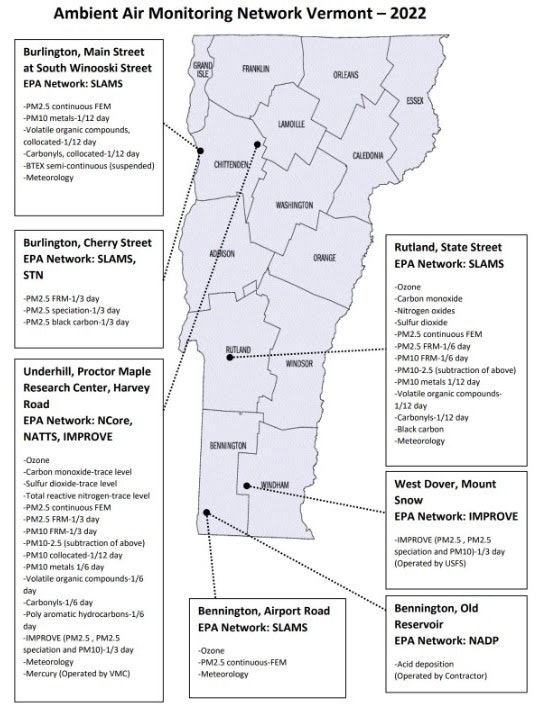Air

Vermont’s air quality is often considered to be among the best in the nation. However, the air we breathe is not pollutant-free. Motor vehicles, building heating systems, and manufacturing all generate air pollution. Our air quality is also affected by emissions that occur outside of the state, from sources such as electricity generating facilities and wildfires. The weather also plays an important role. Brisk winds and fast-moving weather fronts move pollutants out of our area, while stagnant weather systems can cause pollutants to linger and accumulate, particularly in mountain valley areas.
As the seasons change, so do the sources and causes of decreased air quality. Hazy, hot summer days, combined with increased motor vehicle emissions during “driving season”, can result in increased concentrations of ground level ozone and volatile organic compounds contained in fossil fuel. As winter and “heating season” arrives, emissions from furnaces and boilers, in particular those using wood for fuel, increase and can be trapped in valley areas during temperature inversion events. Throughout the year, fuel burning, agriculture, and industry release heat-trapping greenhouse gasses such as carbon dioxide, methane, nitrous oxide, and sulfur hexaflouride into the atmosphere.
The federal Clean Air Act identifies six common air pollutants:
- Ground Level Ozone
- Sulfur Dioxide
- Nitrogen Dioxide
- Particulate Matter
- Lead
- Carbon monoxide
Ambient air monitoring is essential for state and federal environmental planning, enforcement efforts, air pollutant trends analysis, and providing timely air quality health advisories. Vermont began air monitoring in the 1960s with a focus on total suspended particulate (TSP). Vermont established an air monitoring network for criteria pollutants in the 1970s and a network for monitoring toxic air pollutants in 1985. The Vermont AQCD currently operates and maintains five permanent air monitoring stations to measure the six EPA criteria air pollutants and 96 air toxic pollutants .
Real time air quality data from each of the monitoring stations listed above can be found at https://dec.vermont.gov/air-quality/Air-Quality-Data
Data From:
Air Pollutants and Health | Department of Environmental Conservation
Vermont Annual Air Monitoring Network Plan 2022 Vermont Department of Environmental Conservation Air Quality & Climate Division July 1, 2022
